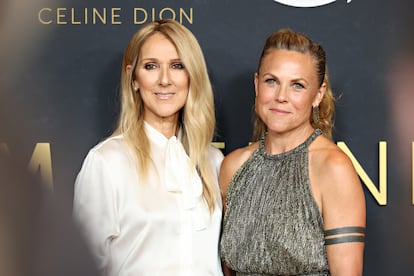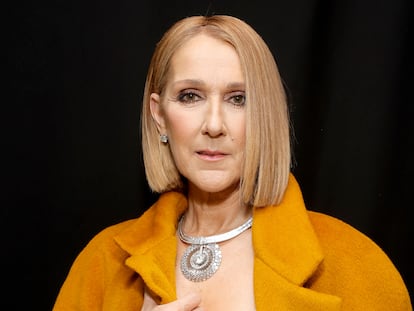When Céline Dion hated herself for not being able to sing: Valium and pain in the singer’s most personal documentary
Irene Taylor, the director of ‘I Am: Céline Dion’, which premieres on June 25 on Amazon Prime Video, tells EL PAÍS that the artist gave her carte blanche to film the hardest moments of her struggle with stiff person syndrome


Twelve minutes of footage are what mark the beginning of the Céline Dion documentary. The 120-minute running time of I Am: Céline Dion — the film directed by Irene Taylor that can be seen on Amazon Prime Video as of June 25 — does not start with a very young Dion, with arched eyebrows and frizzy hair, saying that her dream is to be “an international star and be able to sing all her life” while an aria from Bizet’s Carmen plays in the background. Nor with her teenage twins, Eddy and Nelson, jokingly interviewing her and asking her about her favorite color. Not even with the poster that explains that — after releasing 27 albums, selling 250 million records and being nominated for Grammys and Oscars — Dion has had to stop and cancel her 2021 tour due to stiff person syndrome.
The moment when the viewer really sits in front of the 56-year-old artist is when she shares — under dim light, without makeup, with her face swollen due to medication — how one morning, after breakfast, her voice was not her own. “I freaked me out a little bit,” she recalls. The night before, everything was going well. But that morning everything was going wrong. She was wracked by fear and nerves. And she then shows how this affected her. Dion opens her mouth, emits a note... and it doesn’t come out. Her voice breaks. As if she were any mortal, not the Canadian who belted the power anthems My Heart Will Go On and The Power of Love. She can’t sing the note, and she starts to cry. The whole scene is recorded by the cameras.
It’s an incredible moment. It doesn’t matter how many times she repeats the story (many) or how many times, the viewer rewatches it (maybe even more). It is a huge surprise to see Dion being unable to sing. That broken notes emerge from her highly trained throat, unable to even reach the tenth power of what they were. She describes, crying, how she hates these notes.
Just as shocking is the scene when Dion has a five-minute spasm attack, which paralyzes her in the middle of the shoot and forces her to seek medical help. It makes your hair stand on end. But what is most surprising is knowing that it was Dion herself who decided to film the worst moments of her illness. Director Irene Taylor, 54, is the director of the documentary. In an exclusive interview with EL PAÍS, Taylor explains that it was the singer herself who wanted to give her complete access and have those difficult scenes recorded: she set no limits on what about be shown about herself. “The first day I filmed with her, I was actually shocked. Really shocked by how open she was with me. She was wanting to share so many things with me, things I didn’t even know about,” the director recalls about recording the documentary, which lasted months.
“During that year, I think she made a very conscious decision: I’m going to not tell Irene what to do. I’m going to trust her and let her do her job. And you know, that is how she works with people in her life,” the director reflects over a video call. “She has managers, assistants, musicians who she collaborates with, and they have worked with her for decades. That tells me a lot about her. She knows how to delegate, and then she lets people have autonomy, and that’s very important.”
As a chronically ill person and as a global artist, showing her struggles — even while wearing necklaces belonging to Maria Callas and living in a mansion in Nevada — is a conscious decision that connects her to a universal audience, and also allows others to relate to her. She is seen with her wrinkles and spots, without hair and makeup, as she does physical therapy sessions in socks. The singer talks about how she started with “one pill, two pills, five pills, too many pills” and ended up taking “80, 90 milligrams of Valium per day” — and that was just medication. She is calm when she says that her condition affects “one in a million.” And that, like so many others with other diseases, she has developed this one, which makes it no less of a tragedy.
The documentary — which will also be screened at selected movie theaters as of midweek — lets Dion herself tell her story. There are plenty of people around her — musicians, assistants, her children — but Dion’s voice is the only one telling the story. According to Taylor, that was the only request the singer ever made of her. “Before we decided to make the film, she asked me, ‘Is it possible to make a documentary that would not have people talking about me by just letting me talk about me. What if my voice was the only voice in the film? Is that possible?’” says Taylor. “And I told her, it’s absolutely possible. And in fact, that is my ideal movie to make. So if that’s what you want, you tell me, but you need to get ready, because it’s going to take a lot of time and effort. You’re going to have to spend a lot of time with me,” she adds, smiling.
It is true that the Céline Dion documentary could be a compilation of her life and work, almost a eulogy, a testament that could be seen now or in 50 years, in which the singer is seen talking to her children, showing her warehouse full of haute couture clothes, and even receiving medical treatment. But what makes I Am: Céline Dion so unique and powerful are the immensely personal scenes, where Dion breaks down and gets angry at herself for not being able to control her body: “I’m tremendously ashamed,” she says in one moment, throwing her hands to her head. The scenes where she describes how her voice has been the compass that has guided her, but that she has been suffering from spasms for 17 years. Where she talks about trying to hide the spasm if she had an attack during in a performance (“I did what my mom said”). And where she says that she cannot live without music, and even less so without the support of the public: “The fans give me energy, lots of it.”
Is I Am: Céline Dion perhaps the most definitive documentary about the global Canadian artist? Taylor doesn’t have an answer to this, as she deliberately made sure she knew as little as possible about the singer, and purposefully did not watch any of the other documentaries about her. “I respect the filmmakers, but you know, in my process, I was not wanting to rely on other people’s interpretations. I wanted to go with a fresh look,” say the director.
The producers looked for material about the artist — the documentary features many old, professional and home recordings — and only told Taylor about the singer’s “basic biographical details, family life, things like that.” “But I really did not want to ask questions that were fake. I didn’t want to ask her trick questions, like, I know the answer to this, but I’m going to ask them anyway,” she says. “Over the course of the year [of filming], when I asked questions, they were very honest questions I did not know the answer to.”
Taylor, on the other hand, accepts every question. The interview is very short, but she is delighted to explain the documentary, for people to see it, to “have given birth to it,” she laughs. The Amazon team only request that one question not be asked of Taylor: there can be no inquiries about Dion’s health or her future plans regarding her health. Taylor is not Dion, after all. The singer has given very few interviews (speaking to Vogue and People) and remains in her home in Las Vegas. Sometimes she can’t walk or warm up her voice. She spends her time receiving care, having naps and taking piles of medicine. And training for his next show, because Dion is clear that she will be back on stage. As she herself says in the documentary: “It’s not hard to do a show. It’s hard to cancel a show.”
Sign up for our weekly newsletter to get more English-language news coverage from EL PAÍS USA Edition
Tu suscripción se está usando en otro dispositivo
¿Quieres añadir otro usuario a tu suscripción?
Si continúas leyendo en este dispositivo, no se podrá leer en el otro.
FlechaTu suscripción se está usando en otro dispositivo y solo puedes acceder a EL PAÍS desde un dispositivo a la vez.
Si quieres compartir tu cuenta, cambia tu suscripción a la modalidad Premium, así podrás añadir otro usuario. Cada uno accederá con su propia cuenta de email, lo que os permitirá personalizar vuestra experiencia en EL PAÍS.
¿Tienes una suscripción de empresa? Accede aquí para contratar más cuentas.
En el caso de no saber quién está usando tu cuenta, te recomendamos cambiar tu contraseña aquí.
Si decides continuar compartiendo tu cuenta, este mensaje se mostrará en tu dispositivo y en el de la otra persona que está usando tu cuenta de forma indefinida, afectando a tu experiencia de lectura. Puedes consultar aquí los términos y condiciones de la suscripción digital.
More information
Archived In
Últimas noticias
Most viewed
- Sinaloa Cartel war is taking its toll on Los Chapitos
- Oona Chaplin: ‘I told James Cameron that I was living in a treehouse and starting a permaculture project with a friend’
- Reinhard Genzel, Nobel laureate in physics: ‘One-minute videos will never give you the truth’
- Why the price of coffee has skyrocketed: from Brazilian plantations to specialty coffee houses
- Silver prices are going crazy: This is what’s fueling the rally










































